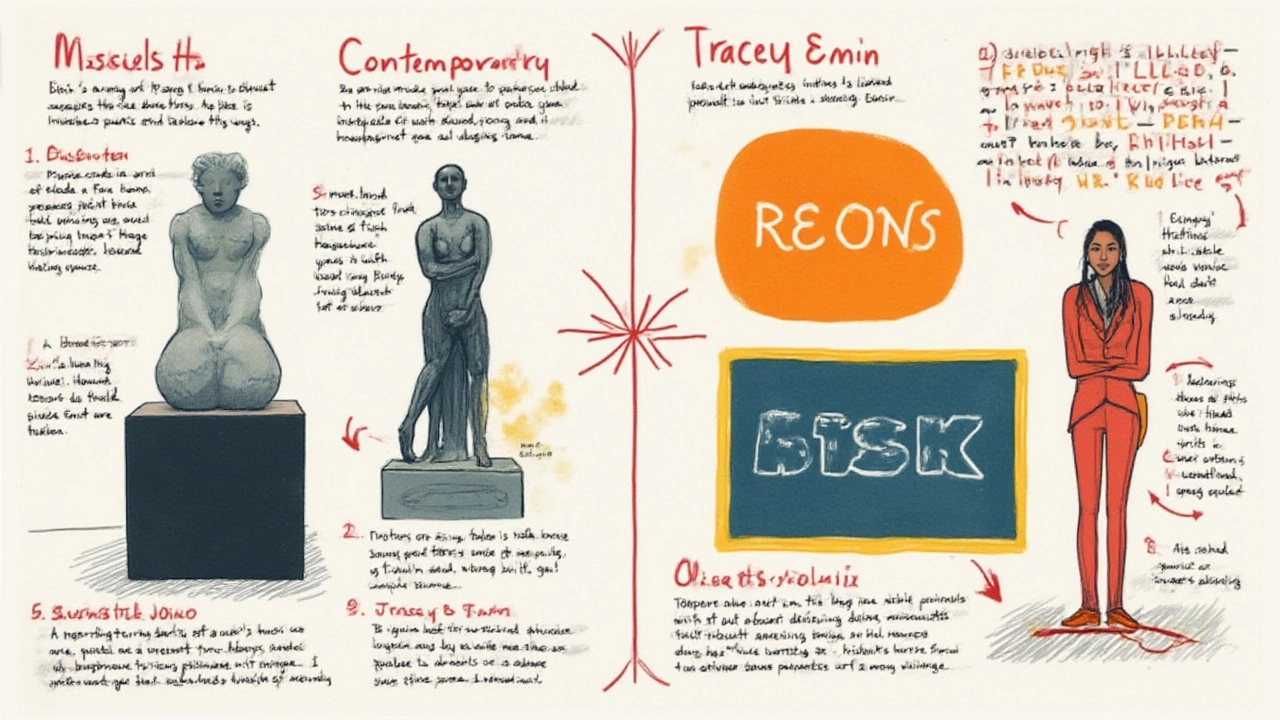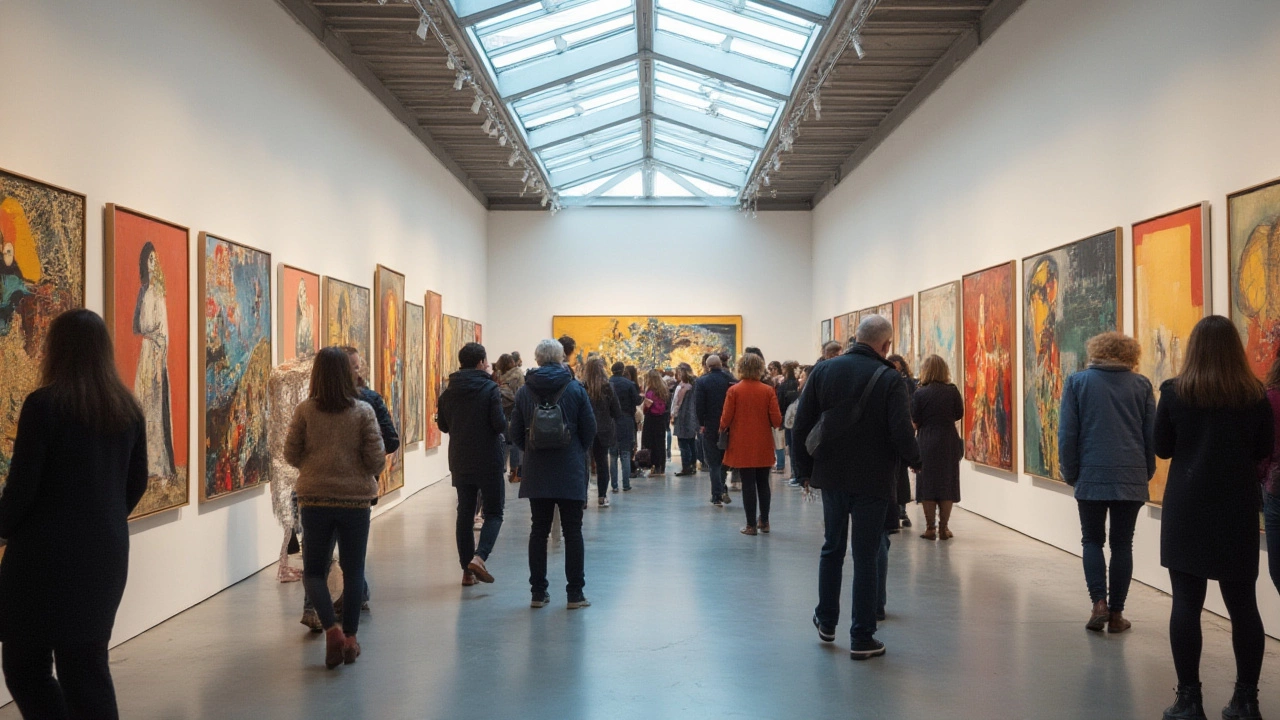People toss around the words "modern art" and "contemporary art" like they’re basically the same thing. Museums slap on the labels, auction houses hype up record sales, and every time you see a quirky sculpture, someone says, “That’s got to be contemporary.” But here’s the curveball: they actually mean different things, though admittedly the line between them is blurrier than the Sheffield weather forecast. Grab a cuppa and dive deep, because untangling this art-world riddle actually helps you enjoy, critique, and maybe even collect art with more confidence—and a dash of smugness, if that’s your thing.
The Timeline: When Modern and Contemporary Art Began
Pinning down the difference starts with time. Most people think "modern" equals "now." In the art world, that’s not the case. Modern art kicked off around the 1860s, riding the shockwaves brought by the Industrial Revolution. Artists like Monet, Cézanne, and Van Gogh tore away from perfectly polished portraits and landscapes. They wanted art to capture fleeting moments, wild movement, and emotion—even if it looked rough around the edges. No more painting kings and queens exactly as they sat; it was about how it felt to look at something, not just how it looked.
By the time the world crashed into the late 1940s and 1950s, a new mindset was brewing. That’s when contemporary art entered the chat. The line isn’t sharp—it fuzzes together as World War II ends. Basically, "contemporary" means "art of our time," but because time moves, the art keeps changing. If you’re reading this in 2025, contemporary art usually means work from the mid-20th century up to right now.
A quick timeline for reference:
| Period | Years | Main Movements |
|---|---|---|
| Modern Art | ~1860s–1970s | Impressionism, Cubism, Surrealism, Abstract Expressionism |
| Contemporary Art | 1970s–Present | Conceptual Art, Pop Art, Street Art, Digital Art |
Why did modern art "end" and contemporary "begin"? Think of it as the moment artists stopped caring about making something necessarily pretty or even physical. Post-war artists wanted art to tackle bigger issues: politics, equality, technology, and even what "art" itself meant. Cue installations, video art, and protests-in-the-shape-of-paintings.
Defining Features: What Sets Modern and Contemporary Apart?
Spotting the difference is sometimes trickier than telling lager from ale in a dark pub. Modern art loves innovation—think breaking perspective or ditching realistic color. Picasso’s faces, Mondrian’s squares, and Jackson Pollock’s splatters didn’t exist to make you comfortable. They wanted reaction, for better or worse. Bottom line: modern artists used new styles to comment on the world, change how we see everyday things, and rebel against academic rules.
Contemporary art, on the other hand, is even less about technique and more about ideas. You don’t need paint at all. A pile of bricks, a sound recording, a meme on a screen—all fair game. Politics, identity, climate change, pop culture—all these subjects are on the table. Banksy’s street art, Yayoi Kusama’s infinity rooms, and Ai Weiwei’s installations rub elbows with digital works by folks you’ve never heard of. The shock is less about "That looks weird!" and more "What’s this trying to say?"
Here are some tips if you’re squinting at a painting or sculpture, unsure which camp it belongs in:
- If it plays with light, color, impressions, or abstract forms but feels like it’s still about the medium—probably modern.
- If it’s making a point about society, technology, or current events, or isn’t even made of traditional materials—likely contemporary.
- If you see computers, VR headsets, social media references, or anything that shouts “now”—definitely contemporary.
But don’t sweat it too much. Even art historians debate some works. Andy Warhol’s Campbell’s Soup cans? They sit right on that border, sparking long arguments in university halls (and on Twitter).
Major Artists and Iconic Works from Each Period
Let’s put faces to the movements. Modern art reads like a greatest-hits playlist. You’ve got Edouard Manet, kicking things off with "Olympia" in 1863—a painting so shocking, it nearly got him banned from polite Parisian society. Then there’s Vincent van Gogh, probably the world’s most beloved tragic figure, painting "Starry Night" in a frenzy. Picasso changes art forever with "Les Demoiselles d’Avignon," slicing up perspective like a pizza. Later on, Piet Mondrian decides a few colored rectangles can say it all, and Mark Rothko stretches fields of color so big they swallow you whole.
Flip to contemporary art and you’ll find totally different vibes. Banksy, the anonymous street artist (rumoured to be from Bristol, not far from Sheffield, mind you), shreds his own work at auction. Ai Weiwei piles up millions of sunflower seeds in the Tate Modern, each one hand-painted by workers in China. Tracey Emin displays her unmade bed (“My Bed” literally was her childhood bed and filled with the detritus of heartbreak—used condoms, cigarette butts, and all). James Turrell turns entire rooms into immersive light experiences, playing with the way your eyes process color.
- Modern Art Icons: Claude Monet, Pablo Picasso, Henri Matisse, Georgia O’Keeffe, Jackson Pollock, Frida Kahlo, Marcel Duchamp
- Contemporary Art Icons: Yayoi Kusama, Damien Hirst, Ai Weiwei, Banksy, Tracey Emin, Cindy Sherman, Gerhard Richter
Their work isn’t just in museums. You’ll see them in pop culture, protest signs, album covers—even memes. Some pieces command eye-watering sums at auction. In 2021, Beeple’s digital artwork “Everydays: The First 5000 Days” sold as an NFT for $69 million (£50 million)—something unthinkable in Monet’s era.
Why the Difference Matters Today
Spotting the line between modern and contemporary art isn’t just for trivia night. It helps you make sense of the wild, sometimes confusing, art you see in galleries, on street corners, and scrolling through Instagram. An artist who started in the 1950s could still be alive and kicking today, hanging out with fresh-faced TikTok painters, but their mental toolkit is totally different. Modern art often asks: "How do I represent the world differently?" Contemporary art asks: "How do I comment on the world—and maybe even change it?"
People get worked up when they see an artwork selling for millions that looks like paint splatter or a banana taped to a wall. "That can’t be art!" they say. But knowing the context—the question the artist asked, the time they lived in—frames the work differently. When Marcel Duchamp exhibited a signed urinal in 1917 (“Fountain”), it was modern art’s way of trolling the whole concept of what counts as art. Fast forward to Damien Hirst suspending a shark in a tank of formaldehyde: contemporary art, and the shock value takes new turns.
If you’re collecting, investing, or just curious, this boundary makes a difference. Modern art is usually signed, dated, and done. Contemporary art is still being made, still sparking arguments, and still totally unpredictable.

Tips for Navigating Modern and Contemporary Art
You’re standing in a gallery and hear the words "modern" and "contemporary" thrown around. How do you keep it straight? Start by looking for labels—and don’t be afraid to ask questions. But here’s some practical advice to help you slice through the confusion like a hot knife through butter:
- Check the dates. If it’s pre-1970s, probably modern. Post-1970s? Likely contemporary.
- Assess the materials. Oil on canvas? Could be either, but installations, videos, found objects? That’s contemporary’s playground.
- Consider the message. Modernists riffed on style; contemporaries riff on meaning and commentary.
- Look up the artist. Many jump periods, but their most famous work usually sits on one side of the divide.
- Explore digital catalogues. Museums like the Tate, MoMA, and The National Gallery spell out which camp an artwork belongs in—handy when you need clarity.
- Follow trends. Social change, new tech, and global movements usually show up first in contemporary art.
If you visit a Sheffield gallery, you’ll likely spot both. The Millennium Gallery will wow you with local heroes like Pete McKee—his work is technically contemporary but deeply rooted in the city’s story.
| Quick Reference | Modern Art | Contemporary Art |
|---|---|---|
| Dates | 1860s–1970s | 1970s–Now |
| Common Media | Paintings, sculpture | Anything—digital, installations, performance |
| Famous Artists | Picasso, Pollock, Matisse | Kusama, Banksy, Ai Weiwei |
| Main Focus | Breaking from tradition | Challenging ideas, making statements |
Don’t let labels box you in. Ultimately, art’s there to provoke, delight, and sometimes annoy. Whether you love it or want to walk away, knowing the difference between modern and contemporary art cracks open a story that’s still being written. Got a favourite? Next time you’re at a museum or scrolling Instagram, see if you can tell which world it fits into—and why that little detail matters more than most people realise.

